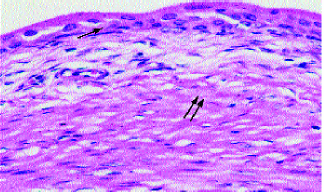Mega-organs, primarily in the digestive tract, are well known to occur in chronic Chagas disease. Acute experimental infection with Trypanosoma cruzi results in parasitism of a wide range of cells, tissues, and organs, including the urinary bladder. Infection of BALB/c mice with 100,000 bloodstream forms of the Y strain of T. cruzi induced acute infection with intense parasitism of all layers of the urinary bladder. Parasites were found in the mucosa, lamina propria, muscular, adventitial connective, and fat tissue. Desquamate epithelial cells with amastigotes in the bladder lumen were also found. After 60 days of infection, mice inoculated with 50 bloodstream forms developed dilated, thin-walled bladders that had inflammatory infiltrates and foci of fibrosis replacing areas of damaged muscular layer. These lesions result from direct damage to the muscle fibers by the T. cruzi, leading to myosites, muscle damage, and scarring. Direct damage of paraganglia cells secondary to parasitism, leading to dilatation, damage of muscle fibers, and scarring with replacement of muscular tissue with connective tissue, should also be considered as a cause of functional disturbance of the urinary bladder.
Trypanosoma cruzi; Urinary bladder; Pathology





